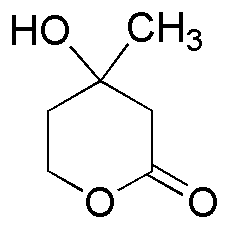(±)-Mevalonolactone is widely utilized in research focused on
- Biochemical Research: It serves as a key intermediate in the biosynthesis of terpenes and steroids, making it essential for studies in metabolic pathways.
- Pharmaceutical Development: This compound is used in the synthesis of various drugs, particularly those targeting cholesterol metabolism, offering potential benefits in treating cardiovascular diseases.
- Biotechnology: It plays a role in the production of biofuels and bioplastics, contributing to sustainable practices in the industry.
- Food Industry: As a flavoring agent, it enhances the taste profile of certain food products, appealing to manufacturers looking to improve product quality.
- Cosmetic Formulations: Its antioxidant properties make it valuable in skincare products, helping to protect skin from oxidative stress and improve overall skin health.
Informations générales
Propriétés
Sécurité et réglementation
Applications
(±)-Mevalonolactone is widely utilized in research focused on
- Biochemical Research: It serves as a key intermediate in the biosynthesis of terpenes and steroids, making it essential for studies in metabolic pathways.
- Pharmaceutical Development: This compound is used in the synthesis of various drugs, particularly those targeting cholesterol metabolism, offering potential benefits in treating cardiovascular diseases.
- Biotechnology: It plays a role in the production of biofuels and bioplastics, contributing to sustainable practices in the industry.
- Food Industry: As a flavoring agent, it enhances the taste profile of certain food products, appealing to manufacturers looking to improve product quality.
- Cosmetic Formulations: Its antioxidant properties make it valuable in skincare products, helping to protect skin from oxidative stress and improve overall skin health.
Documents
Fiches de données de sécurité (FDS)
La FDS fournit des informations de sécurité complètes sur la manipulation, le stockage et l’élimination du produit.
Spécifications du produit (PS)
Le PS fournit une description complète des propriétés du produit, notamment sa composition chimique, son état physique, sa pureté et les exigences de stockage. Il détaille également les plages de qualité acceptables et les applications prévues du produit.
Certificats d'analyse (COA)
Recherchez des certificats d'analyse (COA) en saisissant le numéro de lot du produit. Les numéros de lot et de lot se trouvent sur l'étiquette d'un produit, après les mots « Lot » ou « Lot de fabrication ».
Numéro de catalogue
Numéro de lot/série
Certificats d'origine (COO)
Ce certificat d'exploitation confirme le pays dans lequel le produit a été fabriqué, et détaille également les matériaux et composants utilisés et s'il est issu de sources naturelles, synthétiques ou autres sources spécifiques. Ce certificat peut être requis pour les douanes, le commerce et la conformité réglementaire.
Numéro de catalogue
Numéro de lot/série
Fiches de données de sécurité (FDS)
La FDS fournit des informations de sécurité complètes sur la manipulation, le stockage et l’élimination du produit.
DownloadSpécifications du produit (PS)
Le PS fournit une description complète des propriétés du produit, notamment sa composition chimique, son état physique, sa pureté et les exigences de stockage. Il détaille également les plages de qualité acceptables et les applications prévues du produit.
DownloadCertificats d'analyse (COA)
Recherchez des certificats d'analyse (COA) en saisissant le numéro de lot du produit. Les numéros de lot et de lot se trouvent sur l'étiquette d'un produit, après les mots « Lot » ou « Lot de fabrication ».
Numéro de catalogue
Numéro de lot/série
Certificats d'origine (COO)
Ce certificat d'exploitation confirme le pays dans lequel le produit a été fabriqué, et détaille également les matériaux et composants utilisés et s'il est issu de sources naturelles, synthétiques ou autres sources spécifiques. Ce certificat peut être requis pour les douanes, le commerce et la conformité réglementaire.


